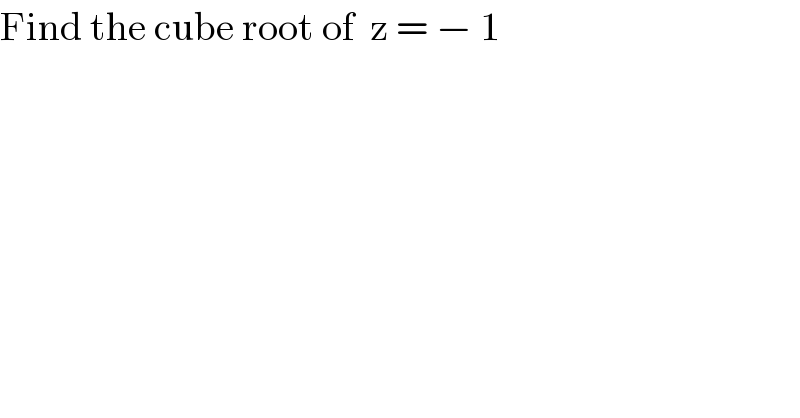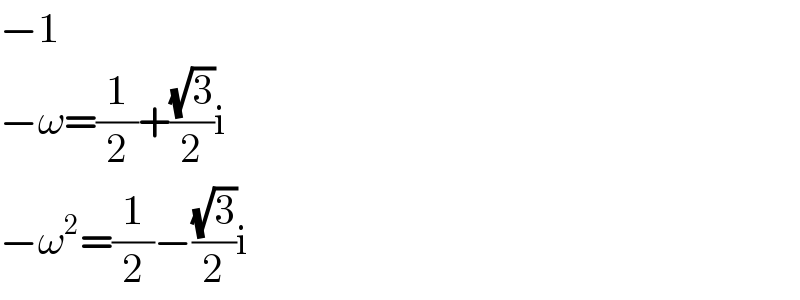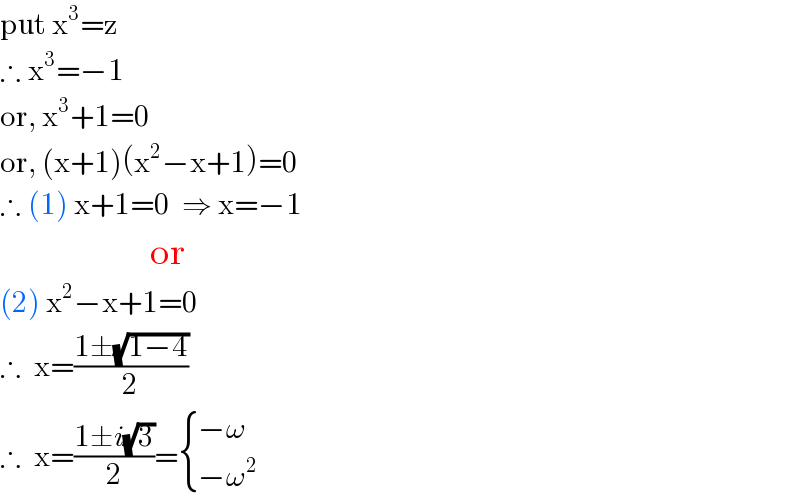
Question Number 17392 by tawa tawa last updated on 05/Jul/17

$$\mathrm{Find}\:\mathrm{the}\:\mathrm{cube}\:\mathrm{root}\:\mathrm{of}\:\:\mathrm{z}\:=\:−\:\mathrm{1} \\ $$
Answered by mrW1 last updated on 05/Jul/17

$$−\mathrm{1} \\ $$$$−\omega=\frac{\mathrm{1}}{\mathrm{2}}+\frac{\sqrt{\mathrm{3}}}{\mathrm{2}}\mathrm{i} \\ $$$$−\omega^{\mathrm{2}} =\frac{\mathrm{1}}{\mathrm{2}}−\frac{\sqrt{\mathrm{3}}}{\mathrm{2}}\mathrm{i} \\ $$
Commented by tawa tawa last updated on 05/Jul/17

$$\mathrm{God}\:\mathrm{bless}\:\mathrm{you}\:\mathrm{sir}. \\ $$
Answered by Arnab Maiti last updated on 07/Jul/17

$$\mathrm{put}\:\mathrm{x}^{\mathrm{3}} =\mathrm{z} \\ $$$$\therefore\:\mathrm{x}^{\mathrm{3}} =−\mathrm{1} \\ $$$$\mathrm{or},\:\mathrm{x}^{\mathrm{3}} +\mathrm{1}=\mathrm{0} \\ $$$$\mathrm{or},\:\left(\mathrm{x}+\mathrm{1}\right)\left(\mathrm{x}^{\mathrm{2}} −\mathrm{x}+\mathrm{1}\right)=\mathrm{0} \\ $$$$\therefore\:\left(\mathrm{1}\right)\:\mathrm{x}+\mathrm{1}=\mathrm{0}\:\:\Rightarrow\:\mathrm{x}=−\mathrm{1} \\ $$$$\:\:\:\:\:\:\:\:\:\:\:\:\:\:\:\:\:\:\:\:\:\:\:\:\:\mathrm{or} \\ $$$$\left(\mathrm{2}\right)\:\mathrm{x}^{\mathrm{2}} −\mathrm{x}+\mathrm{1}=\mathrm{0} \\ $$$$\therefore\:\:\mathrm{x}=\frac{\mathrm{1}\pm\sqrt{\mathrm{1}−\mathrm{4}}}{\mathrm{2}} \\ $$$$\therefore\:\:\mathrm{x}=\frac{\mathrm{1}\pm{i}\sqrt{\mathrm{3}}}{\mathrm{2}}=\begin{cases}{−\omega}\\{−\omega^{\mathrm{2}} }\end{cases} \\ $$
